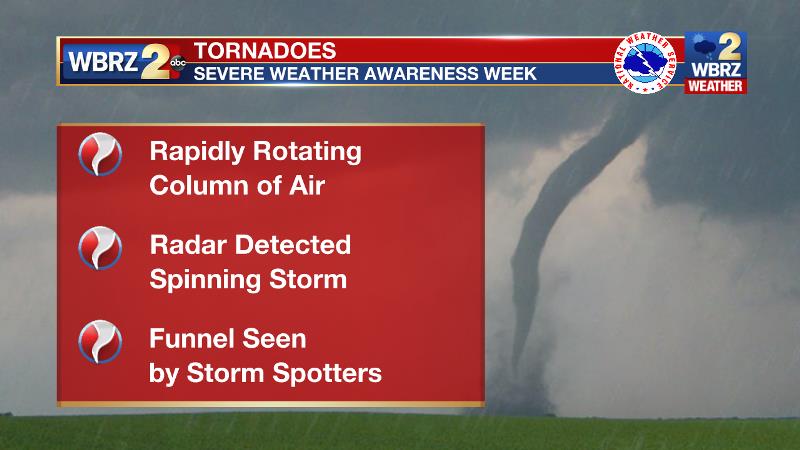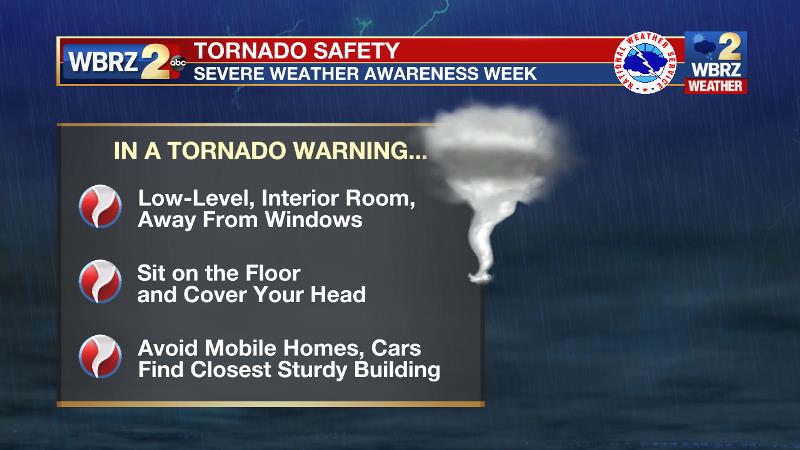What you should know: tornadoes
A Tornado Warning is issued when the National Weather Service detects a rotating thunderstorm capable of producing a tornado, or storm spotters confirm that one is on the ground. A tornado emergency is declared when populated areas are in the path of a confirmed tornado on the ground.

A tornado is a rotating column of air that extends from a thunderstorm cloud to the ground. Tornadoes are capable of completely destroying well-made structures, uprooting trees, and hurling objects through the air like deadly missiles. The sight of these monsters and their swirling path of devastation is often unmistakable.
Strength measured by the speed of their swirling winds, the most violent tornadoes can produce winds over 200mph. The Enhanced Fujita Scale is used to rate tornadoes—officially determined after the fact based on damage observations. The ratings, corresponding wind speeds, and expected damages are as follows:

For Louisiana, tornadoes can occur any time of the year but are most likely in March, April and May with a secondary peak in November. Most occur in the afternoon and evening but are not impossible overnight. Unfortunately, nocturnal tornadoes have a much greater chance of causing fatalities and injuries as many people are asleep and not monitoring weather conditions or media to know if warnings have been issued. Especially in the saturated air of the south—many tornadoes may be rain-wrapped and difficult to see until it is too late, which is why it’s important to take all warnings seriously!
When a tornado warning is issued for your location, take action as you are in an immediately life-threatening situation. Move to a small, low-level, interior room away from windows if possible. Sit on the floor and cover your head. If you are in a mobile home or vehicle, there is no safe place to be! Get out, and seek shelter in the nearest sturdy building.
Trending News

Don’t put yourself in this situation. When a tornado watch is issued, that means tornadic thunderstorms could develop later. Come up with a safe place plan, and consider going there before any warnings are issued.
Stay ahead of severe weather; stay in touch with our weather team on Facebook and Twitter. For more on severe weather awareness week and severe weather safety, CLICK HERE.
Before a Tornado:
Be Weather-Ready: Check the forecast regularly to see if you're at risk for tornadoes. Check in with WBRZ Channel 2 or a NOAA Weather Radio to stay informed about tornado watches and warnings. Check the Weather-Ready Nation for tips.
Sign Up for Notifications: Know how your community sends warnings. Some communities have outdoor sirens. Others depend on media and smart phones to alert residents of severe storms capable of producing tornadoes.
Create a Communications Plan: Have a family plan that includes an emergency meeting place and related information. Pick a safe room in your home, such as a basement, storm cellar, or an interior room on the lowest floor with no windows. Check more ideas for your family plan at: https://www.ready.gov/make-a-plan
Practice Your Plan: Conduct a family severe thunderstorm drill regularly so everyone knows what to do if a tornado is approaching. Make sure all members of your family know to go there when tornado warnings are issued. Don't forget pets if time allows.
Prepare Your Home: Consider having your safe room reinforced. You can find plans for reinforcing an interior room to provide better protection on the Federal Emergency Management Agency website.
Help Your Neighbor: Encourage your loved ones to prepare for the possibility of tornadoes. Take CPR training so you can help if someone is hurt.
During a Tornado:
Stay Weather-Ready: Continue to check in with WBRZ Channel 2 or a NOAA Weather Radio to stay updated about tornado watches and warnings.
At Your House: If you are in a tornado warning, go to your basement, safe room, or an interior room away from windows. Don't forget pets if time allows.
At Your Workplace or School: Follow your tornado drill and proceed to your tornado shelter location quickly and calmly. Stay away from windows and do not go to large open rooms such as cafeterias, gymnasiums, or auditoriums.
Outside: Seek shelter inside a sturdy building immediately if a tornado is approaching. Sheds and storage facilities are not safe.
In a vehicle: Being in a vehicle during a tornado is not safe. The best course of action is to drive to the closest shelter. If you are unable to make it to a safe shelter, either get down in your car and cover your head, or abandon your car and seek shelter in a low lying area such as a ditch or ravine.
After a Tornado
Stay Informed: Continue to check in with WBRZ Channel 2 or a NOAA Weather Radio to stay updated about tornado watches and warnings. Multiple rounds of thunderstorms capable of producing tornadoes are possible during severe weather outbreaks.
Contact Your Family and Loved Ones: Let your family and close friends know that you're okay so they can help spread the word. Text messages or social media are more reliable forms of communication than phone calls.
Assess the Damage: After the threat for tornadoes has ended, check to see if your property has been damaged. When walking through storm damage, wear long pants, a long-sleeved shirt, and sturdy shoes. Contact local authorities if you see power lines down. Stay out of damaged buildings. Be aware of insurance scammers if your property has been damaged.
Help Your Neighbor: If you come across people that are injured and you are properly trained, provide first aid to victims if needed until emergency responders arrive.


